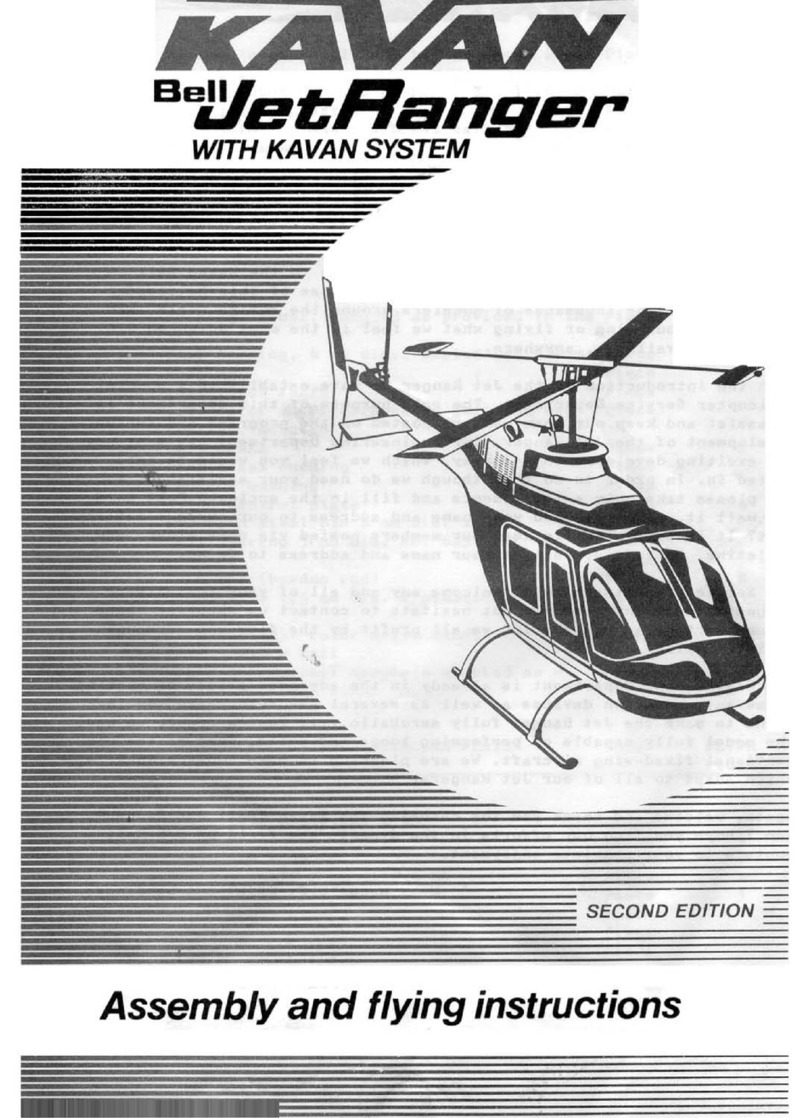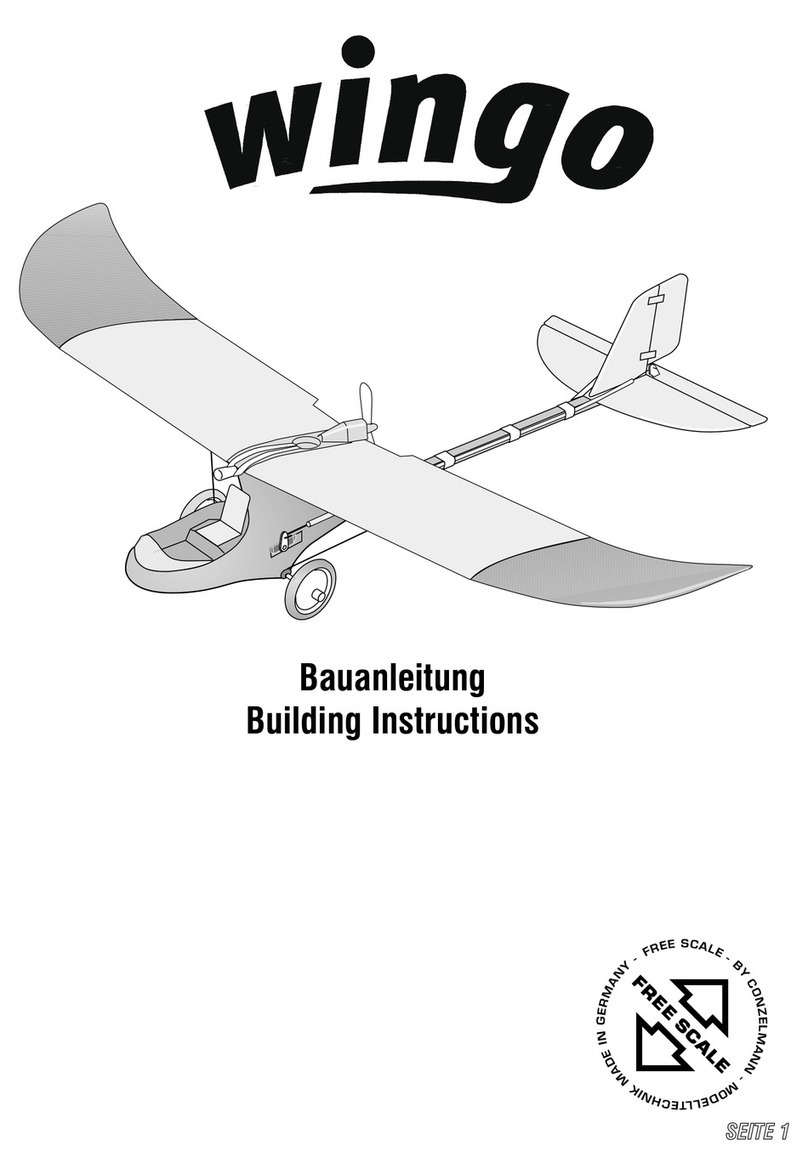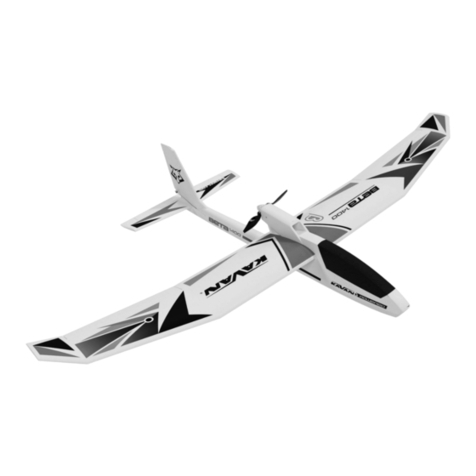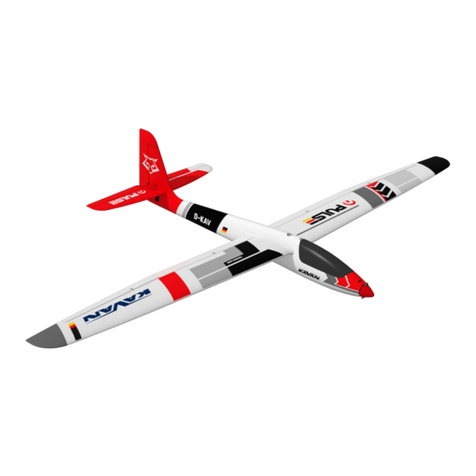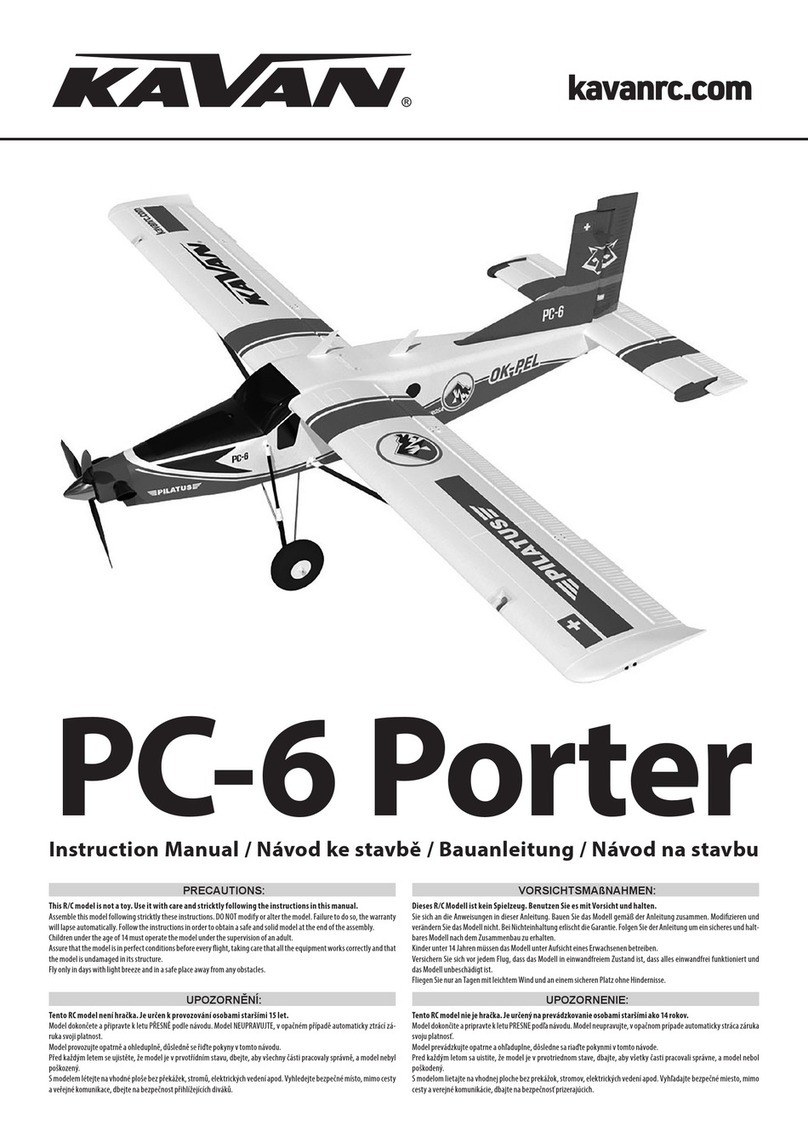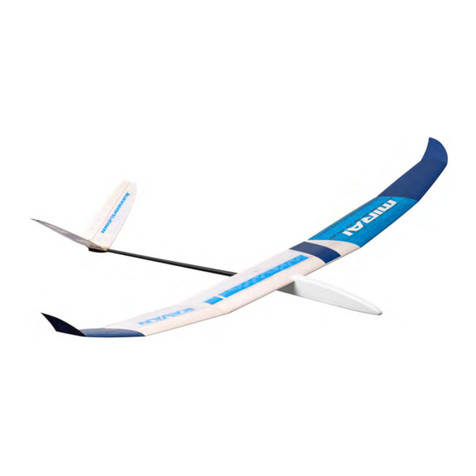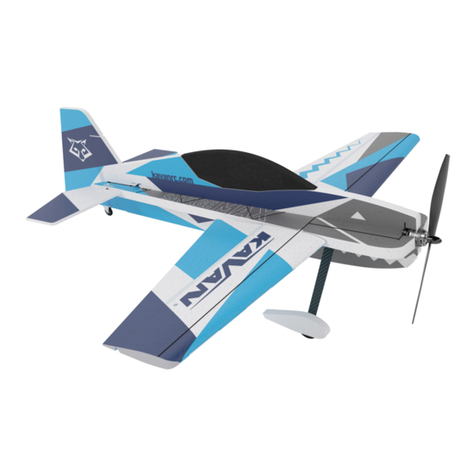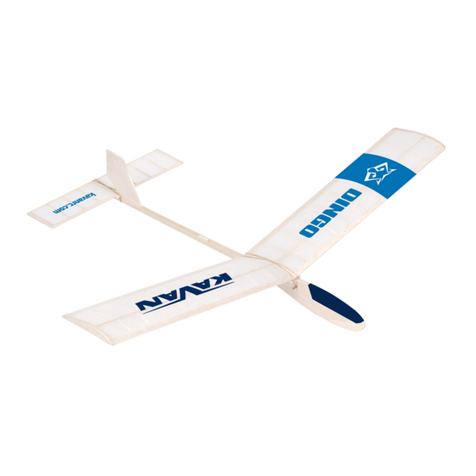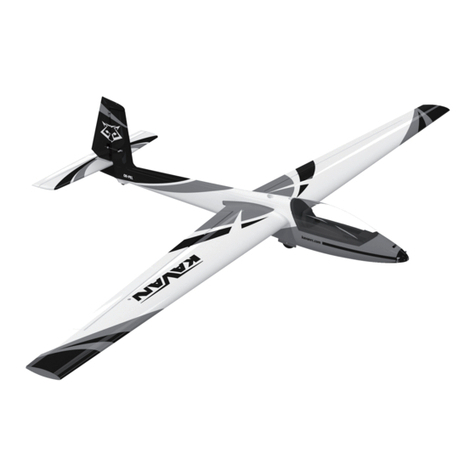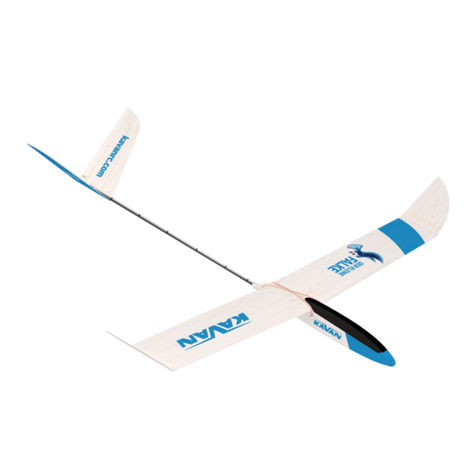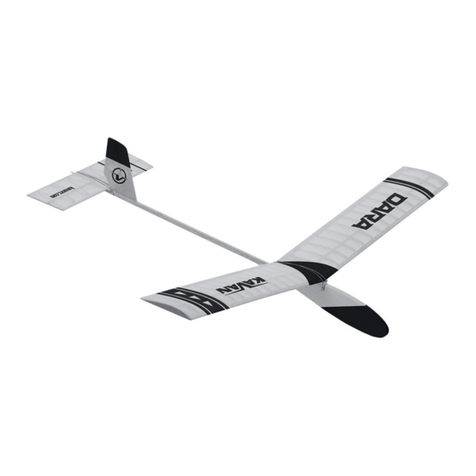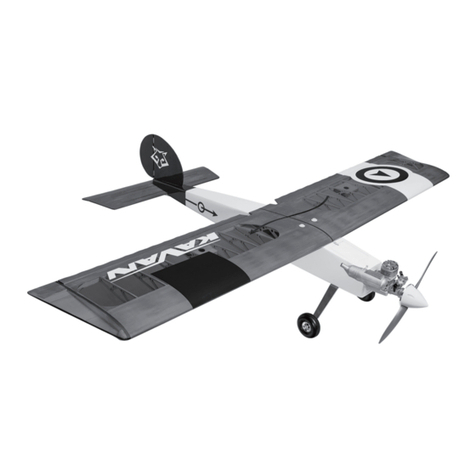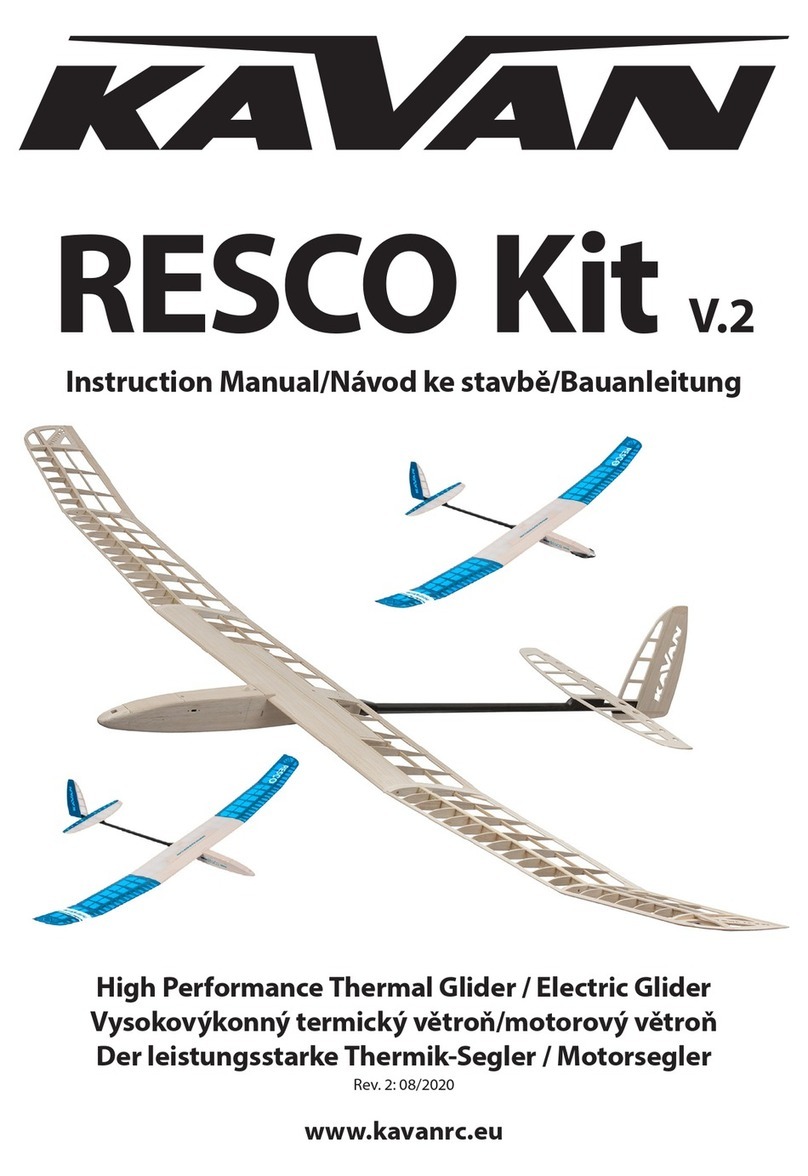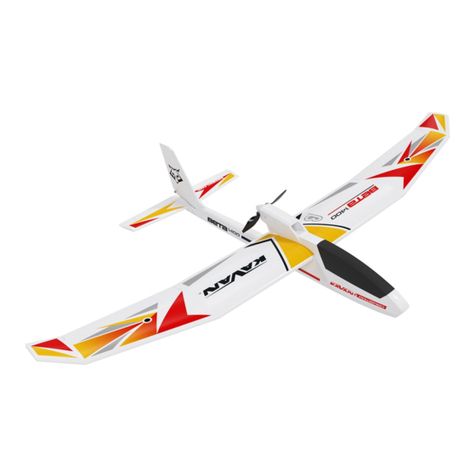
8
7přilepte z obou stran překližkové spojky křídla 42. Styčné plochy zkose-
ných žeber a vyčnívající spojky 42 natřetedůkladnělepidlem apoté jedno
po druhém přilepte obě uši tak, že střední část křídla položíte na rovnou
pracovní plochu a zatížíte (např. opatrně položenými časopisy uloženými
v plastovém sáčku). Uši přitlačte ke střední části křídla na pracovní desce
a podložte je například dřevěným špalíkem nebo knihami tak vysoko, aby
konec ucha byl ve výšce 100 mm nad pracovní deskou. Lepidlo pak ne-
chejte důkladně vytvrdit. Poté spoje uší přebruste, následně i celé křídlo.
Vodorovná ocasní plocha
Vodorovná ocasní plocha (zkráceně VOP) se stejně jako křídlo staví přímo
na plánku chráněném čirou plastovou fólií. Smrkovou odtokovou lištu
(3x5x405 mm) 11 přišpendlete na výkres výškovky s přesahem na obě
strany. K odtokové liště 11 přilepte balsovou podložku (tl. 3mm) 13 a
následně k ní smrkové náběžné lišty (3x5x197 mm) Mezi náběžnou a od-
tokovou lištu vlepte šikmé balsové výztuhy 12, které si postupně nařežete
z balsových lišt 3x5mm. Výztuhy lepte postupně od vnějších konců VOP
směrem ke středu VOP.
Na horní část VOP nalepte smrkový nosník 14 (3x5x395 mm). Na balsovou
podložku 13 přilepte horní přední balsovou podložku (tl. 3mm – 30x30
mm) 16 a dále pak 2 ks zadních balsových podložek (tl. 3 mm – 13,5x45
mm) 17. Obě tyto zadní podložky se přilepí na podkladovou balsovou
podložku 13 tak, aby byly zároveň v rovině boční hrany podložek (horní i
spodní)amezi oběmahornímipodložkami17 byla mezera asi 2,5 mm pro
zalepení bambusového kolíku 18. Do vnějších rohů VOP vlepte výkližky
15, které předem zabrousíte do správného tvaru.
Po dokonalém zaschnutí lepidla VOP sejměte z plánku, zařízněte přesahy
náběžné a odtokové hrany a zaoblete je brusným papírem do tvaru prolu
(Det. A-A). Do tvaru prolu (Det. A-A) zabruste i střední horní balsové
podložky. Po potažení výškovky papírem mezi balsové podložky 17 vlepte
bambusový kolik (bambusová kulatina Φ2,5x50 mm) 18 tak, aby přesa-
hoval odtokovou hranu VOP o 15mm.
Trup a svislá ocasní plocha
Trup má tyčkový nosník ocasních ploch a vpředu hlavici potaženou to-
polovou překližkou s dostatkem místa pro zátěž a případnou instalaci
časovače. Začněte ocasním nosníkem: Na lištu (2x8x595 mm) 22 přilepte
na „tupo“ přední balsový hranol trupu 20 – okraje hranolu jsou v rovině
s okraji lišty – POZOR – na šikmou stranu hranolu později bude nalepen
zadní balsový hranol 21 – viz výkres. Nyní naneste lepidlo na zbylou část
lišty 22 i šikmou část balsového trupu 20 a následně přilepíte (v rovině
s okraji lišty) i zadní hranol trupu 21. Na druhou lištu trupu 2x8 mm 23
naneste lepidlo a na rovné podložce ji přilepte k již slepeným částem
ocasního nosníku.
Pokud hodláte používat časovač, je nyní vhodná doba, abyste pro něj dle po-
třeby upravili výřez v hlavici trupu 24 a vyřízli odpovídající otvor v jednom z
bočních krytů (26 nebo 28).
Slepený ocasní nosník vložte do drážky v hlavici trupu 24. Šířku drážky dle
potřeby upravte pilníkem. Poté ocasní nosník z hlavice vyjměte, naneste
na něj lepidlo a vložte zpět do hlavice trupu. Ocasní nosník s hlavicí lepte
na rovné desce, aby byl celý trup po slepení rovný.
Na sucho, bez lepení zasuňte 2bukové kolíky 25 (Φ4x32 mm) do hlavice
trupu. Tyto kolíky poslouží k přesnému umístění bočních krytů hlavice.
Na jednu stranu hlavice trupu naneste lepidlo a na bukové kolíky nasaď-
te boční kryt trupu 26 a přitiskněte jej k hlavici. Oba lepené díly můžete
položit na pracovní desku a zatížit je závažím. Do hlavice trupu vložte a
zalepte) zátěž 27. Obdobným způsobem přilepte i druhý boční kryt trupu
28.
Do svislé ocasní plochy (zkráceně SOP) 29 vlepte výztuhu 30. Dále slepte
lože vodorovné ocasní plochy. Na překližkovou podložku (tl. 1 mm - 25x15
mm) 31 přilepte smrkovou lištu (3x5x25 mm) 32. Ze stavebního výkresu
odměřte vzdálenost umístění lože VOP od konce trupu a lože VOP nalepte
na trup. Je nutno kontrolovat, aby lože VOP bylo přilepeno tak, aby při
pohledu zepředu byla VOP položená na lože kolmá na boky hlavice trupu
a při pohledu shora byla její náběžná hrana kolmá na podélnou osu trupu.
Na konec trupu přilepte balsovou podložku (tl. 1.5 mm – 8x10 mm) 33. Na
trup (kolmo na VOP) přilepte svislou ocasní plochu 29. Zaoblete náběžnou
a odtokovou hranu směrovky 52; směrovku a její závěsy 53 nainstalujete
až po potažení a nalakování modelu.
Nyní přilepte překližkové lože křídla 36 tak, aby jeho střed byl v podélné
ose trupu a lože bylo kolmé na oba boky trupu.
Do hlavice trupu zalepte oba poutací kolíky křídla 25. Dle stavebního vý-
kresu označte na zadní části trupu místo pro vyvrtání otvorů pro poutací
kolíky výškovky (bambusová kulatina Φ2,5x25 mm) 34 a 35. Ke spodní
části trupu přilepte balsovou ostruhu 37.
Lakování a potahování
Celý model opatrně přebruste jemným brusným papírem a 2x nalakujte
velmi řídkým lepícím lakem (zředěný ředidlem v poměru nejméně 1:1 –
lak musí téci jako voda; nikdy nepoužívejte neředěný lak). Po zaschnutí
každé vrstvy laku celý model znovu přebruste jemným brusným papírem.
Potah modelu je z papíru Vlies. Papír můžete ke kostře modelu přilepit
vodou naředěným disperzním lepidlem nebo jej můžeme rovnou přilako-
vat řídkým lepicím lakem. Papír orientujte vlákny ve směru rovnoběžném
s hlavním nosníkem křídla nebo vodorovné ocasní plochy, nikoliv napříč.
VOP: Nemáte-li ještě větší zkušenosti s potahováním, doporučujeme
začít s vodorovnou ocasní plochou, na které si potahování „nacvičíte“.
VOP potáhněte nejprve zdola jedním pruhem papíru uříznutým tak, aby
po obvodu byl všude přesah aspoň 10 mm – lepidlem natřete náběžnou
a odtokovou lištu a všechna žebra. Papír přiložte na kostru a opatrně při-
hlaďte (pokud používáte lepení lakem, po přiložení papíru na kostru jej
přilakujte po celé ploše řídkým lepícím lakem). Po zaschnutí lepidla (laku)
potahový papír po obvodu ořízněte tak, aby zůstal přesah 4-5 mm. Přesa-
hující papír ohněte dle hrany a přilepte (přilakujte) ke kostře.
Poté VOP potáhněte stejným způsobem jedním pruhem papíru shora –
lepidlem natřete náběžnou a odtokovou lištu, hlavní nosník, střední bal-
sovou výplň a koncová žebra. Šikmá balsová žebra nenatírejte!
Křídlo: Křídlo potáhněte 4-6 pruhy papíru (spodní stranu křídla zkuše-
nější stavitel potáhne jediným pruhem, shora je nutno potahovat zvlášť
střední část křídla a obě uši), které nastříháte s přesahem aspoň 10 mm
po celém obvodu (nezapomeňte, že pruhy pro horní stranu křídla musejí
být širší – horní strana křídla je klenutá). Potahovat začněte opět zespo-
du – lepidlo naneste na náběžnou a odtokovou lištu a všechna žebra,
přiložíte pruh papíru na spodní stranu křídla a papír přihlaďte prsty ke
kostře. Po zaschnutí lepidla (laku) potahový papír po obvodu ořízněte tak,
aby zůstal přesah 4-5 mm. Přesahující papír ohněte dle hrany a přilepte
(přilakujte) ke kostře. V místě lomení křídla je nutno přesahující papír
proříznout a na okrajích koncového oblouku nařezat na krátké (4-8 mm)
úseky a ty poté postupně přilakovat.
Poté obdobným způsobem potáhněte jedním pruhem papíru horní stra-
nu střední části křídla (s přesahem na kořenová žebra uší 47) – lepidlo
naneste na náběžnou a odtokovou lištu, hlavní nosník a všechna žebra.
Přesahující papír již známým postupem ořízněte, ohněte dle hrany a při-
lepte (přilakujte) ke kostře.
Poté potáhněte vždy jedním pruhem papíru obě uši; papír vždy nejprve
přiložte k uchu, tužkou podle ohebného ocelového pravítka na něj narý-
